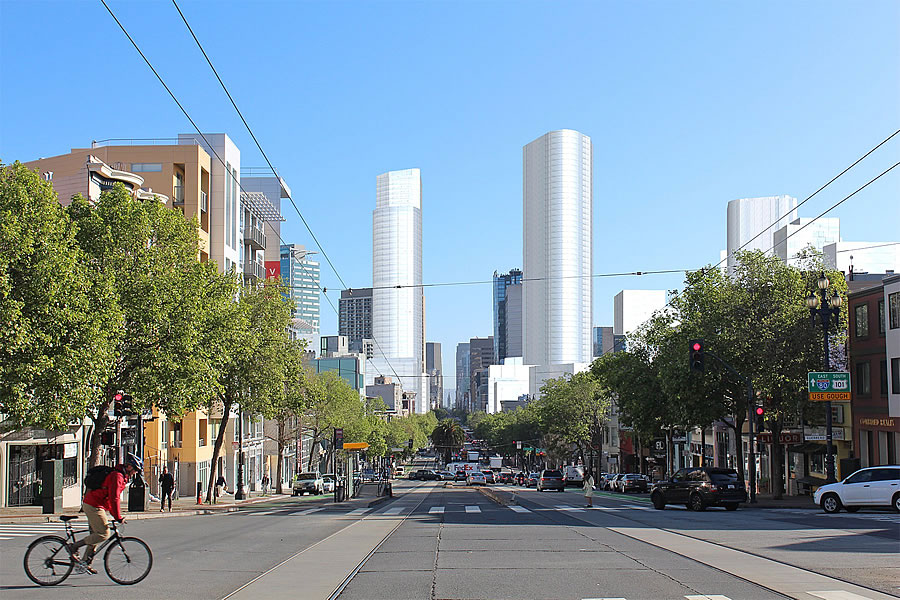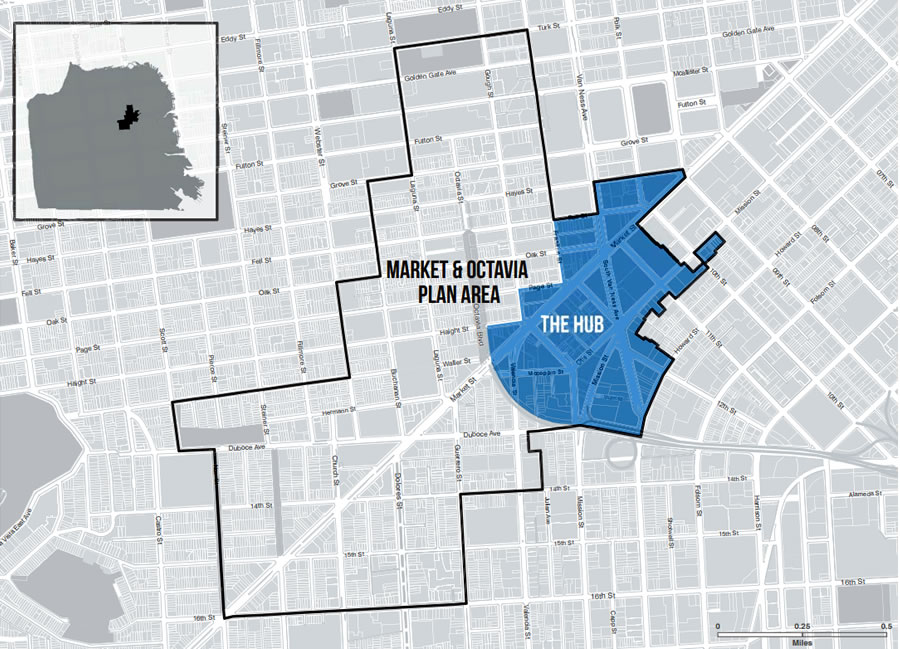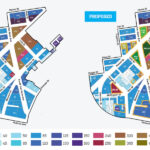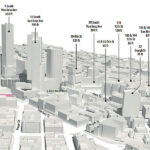The proposed framework for rezoning San Francisco’s 84-acre Hub District, a burgeoning area which is effectively centered around the intersection of Van Ness and Market, within the City’s Market and Octavia Plan Area, has been further refined and is being positioned for adoption by San Francisco’s Planning Commission this March.
In addition to improving and activating the area’s streets, alleys and public realm, the Hub District Plan, which is now formally known as the “Market Octavia Plan Area Amendment,” would allow for the development of “a taller, larger, denser, and more diverse array of buildings and heights,” including the potential for a tower to rise up to 650 feet in height at 1 South Van Ness Avenue, cementing the intersection as the visual hub of the neighborhood.
If adopted, the Plan Area Amendment would now allow for up to 9,710 new residential units to rise within the boundaries of the District, with room(s) for nearly 20,000 new residents, versus a maximum of 8,070 new units as currently zoned.
And while the plan would result in the development of some new office space as well, such as at the base of the proposed tower to rise at 30 Van Ness, the net increase in the number of new area jobs that the plan is projected to yield, accounting for the loss of existing commercial spaces which would be redeveloped, is now effectively zero as compared to today.
Assuming the required amendments to the City’s General Plan, Planning Code and Zoning Map to support the Hub District Plan are approved by Planning, the amendments will then head to San Francisco’s Board of Supervisors for adoption (or not), the public hearings for which are now expected to commence this Summer or possibly this Spring.
We’ll continue to keep you posted and plugged-in.






Should be 1500ft allowance for towers at this key central and super transit rich area, but this is still a good step in the right direction of greater density and more units.
Agreed Oakland lover and instead of just one building at 650, it should be a Minimum of 650! We need density in this city regardless of the nimbys. If they won’t let the city build in other regions, densify the areas that can be built!
I also wish they would have increased heights more (e.g. more 100-300ft parcels where the 85 limits are currently) but this is a great plan (given the unfortunate constraints of SF’s political reality).
These housing units will (hopefully) help compensate for all the new jobs that will be added in the Central SOMA plan. Also, a net benefit for SF’s aesthetic. The renderings for the single tower 10 South Van Ness are beautiful. Hopefully the plan will be adopted ASAP!
Since this is an area plan, does that reduce the overall required approval time for individual projects (i.e. more ministerial)? Also, will these parcels be eligible for Cal State Density Bonus? (so some of those 85″ zone areas could in fact be taller in the end?
Are they going with the single tower or the double shorter ones at 10 South Van Ness? Are the actual renderings of 1 S Van Ness?
[Editor’s Note: Plans for a Single, Taller 984-Unit Hub District Tower Picked]
Any idea as to when 10 SVN might finally get under way?
I work for the company that is the tenant at 10 SVN. We currently have no date for an exodus. Too many things are still in the air.
Thanks for the reply. I realize from a re-reading of the item that nothing can move forward as envisioned until the necessary zoning changes are put in place which it now appears is up to the BOS.
I’m all for increasing density here and think this will be a massive improvement for the neighborhood, however, I do have some concerns regarding Muni capacity at VN station. As it stands now, that station is nearly maxed out during peak hours.
This is all housing, so people will be getting off the trains from further downtown… maybe?
That’s less about the station and more about the stupidly short trains that Muni runs, particularly in the subway.
I agree. Why does muni run 1 car trains at rush hour? I’ve seen no other transit system do that. They just don’t care.
New trains can with up to 3 in a set, so there’s room to improve capacity as more of them come online.
The Breda cars could always run as three car consists. The limiting factor is an old labor agreement whereby every other car needs to be staffed with an operator. When I saw a three car consist run out of West Portal station a few years ago (on a trial basis I assume) – lo and behold, a dude in a yellow vest sits in the cab of the third car staring at the car in front, doing absolutely nothing.
To all the public transportation dreamers: Take note Muni is an employment program first and foremost. Until that changes you can forget about any meaningful improvements
The subway has plenty of capacity. All MUNI has to do is to have all of the surface line passengers transfer to subway at the Church and West Portal stations, and they can run 5 car trains between West Portal and 4th and King and voila! Problem solved.
Essentially the M-Market Subway idea which would be a marked improvement.
Yea. I live in the area on 10th. Van Ness station definitely need some improvements or expansion. Out of the entire long platform, the trains stop at right around the area where the stairs and escalators take up space. So everyone is waiting at a very small area. And 1500 Mission is almost done and 30 Otis is on its way. I hope it’s possible to run longer 4-car or even 6 Castro Shuttle between Embarcadero and West Portal. That will spread out the waiting area for sure.
Will the Market & Octavia Plan Area be called MOPA?
How is this going to work if One Oak in that same area “doesn’t pencil out” under the current 1 free affordable housing unit needs to built for every 3 new market rate units being build by the developer?
The only reason the buildings currently being built are under construction is that they only required around 20% affordable housing offset costs for every new unit being built.
Keep in mind that developers still collect revenues on below market rate (BMR) units, simply at a discounted rate (i.e., developers don’t provide them for “free”). In addition, a major factor of whether or not a project “pencils” is the cost basis of the land.
True, but to offset those revenue loses they charge more for their market rate units. In this environment, with condo prices stagnant/falling, that is not a viable option. The bottom line is the bottom line – give a little here but take more there. The increase in the BMR component to 33% from 20% makes projects at these rezoned sites dubious at best. Unless the developer got the land dirt cheap which is probably the exception and not the rule in the area.
This claim has been made countless times without ever being supported by evidence.
Prices reflect the market as well as costs. As SS notes, land cost is critical.
Isn’t 1 BMR unit for every 3 market rate unit 25% vs 33%? 1/(1+3)= 25%?
None of this is evidence of specific pricing and profit margins. That’s what the unevidenced claims are about.
@socketsitelurker – it is my understanding that the up zoning from Hub 1.0 to Hub 2.0 included a more stringent BMR requirement than the existing BMR requirement. .
…to offset those revenue loses they charge more for their market rate units
That’s incorrect. Market rate housing isn’t valued on a cost-plus basis, developers collect as much as possible for their units (i.e., market rates) irrespective of their underlying costs.
That being said, the need to provide BMR units does impact a developer’s projected returns/margins and a project’s ability to pencil (as does the cost basis of the underlying land and entitlements; the cost of construction, capital and sales; and the pro forma rates which can be collected).
Transit, transit, transit, transit…..
BRT – extend to Cesar Chavez and loop it east to the T-Line linking up to SFGH St.Luke’s and CPMC
Definitely need the trains amped up to 4 car…. current crush capacity means no room on trains and dangeours platforms. / Most will jump Lyft/Uber’s but than again when market street closes car wise, more traffic will be on side streets thus plugging up other major lines 14/14x and 49/47 along with other routes.
I suspect it will be a long time before this moves forward. It is hard to see how it pencils and, especially, as the increased heights of Hub 2.0 come with a higher percentage BMR component. One Oak did not pencil and it was under a less stringent BMR requirement. The nearby 20 story residential proposal on Mission (near 10th?) was abandoned last year as well.
Developers build to make money. There are far greener pastures for them to do that than SF/the Bay Area at this time. The YOY gain in home prices across the nation was almost 6 times that of the Bay Area. The population growth is stagnant – California will lose one Congressional seat after the 2020 census and it is expected to be in the Bay Area which is growing even slower than the slow growth California as a whole. At this point in time this is little more than a pipe dream.
Many developers (not all and not the ones building the massive projects) are local and regional and are not interested in or even able to just move their business to another region. In the context of cheaper American cities, why is Seattle the golden city, Dave? There are far greener places to build than in Seattle, yet Seattle chugs along instead of Rockford, Illinois or Tallahassee.
Regarding the “nearby [21] story residential proposal on Mission…” I think you’re actually referring to 1270 Mission which a 9/17/19 item here indicated had received approvals to proceed in modified form which is seemingly more economically feasible.
Dave, you sing the same old tune about One Oak every time these posts come up, conveniently leaving out the fact that Related is full steam ahead on 1500 Mission, and the City Ballet School parcel is soaring upwards as well, with 550 and 400 +/- units respectively. The key difference here is that Build Inc, in charge of One Oak, has never built anything near to this scale and was in over their heads from the beginning, and a member of the Planning Commission even remarked to me off the record *years* ago that they had zero confidence that Build Inc would be able to construct this tower, commenting that they felt it would be sold to somebody else rather than built by Build Inc.
So, of the three mega towers with approvals, two are being built and one isn’t, but had a serious degree of doubt attached to them behind the scenes for years. With an extremely capable developer behind 10 SVN, my guess is they’ll be moving forward the second they get approvals.
With One Oak, my guess is that Build Inc will sell it to another developer at the beginning of the next cycle and it will go up with them.
Yes as to Build, but its track record does not really change the fundamentals for new SF residential development. Highest construction costs in the world, little appreciation (condos are actually losing value), some of the most stringent BMR requirements in the country and sttagnant population growth. Add to the mix lots of negative national publicity for SF – homeless, filthy streets and now a potentially major city government corruption scandal. Yes, 1500 Mission and the Ballet School are moving forward but they were first proposed during boom times and are trailing indicators. Major TTC residential developments have been nixed (Oceanwide, the Renzo tower and the skinny Howard Street project) in the last year. Those are forward indicators that more accurately tell the tale.
This area will definitely go ahead in full steam. The San Francisco Bay Area is actually the fastest growing region in the state and is still seeing migration into rather than out. Population is at another all time high, and losing a seat is not final or confirmed. California is spending millions to get a more accurate count and it may even GAIN a new seat.
That’s incorrect with respect to the relative growth rate of the Bay Area and net migration.
While the Bay Area population has ticked up to a record high of 7,796,235, the growth rate has dropped to a decade-low of 0.3 percent, versus a little over one (1) percent around Sacramento, and net migration recently turned negative for the first time in a decade as well.
At the same time, Riverside and San Bernardino counties posted the highest numeric population gains over the past year (up 0.94 and 0.86 percent respectively) and accounted for 29 percent of the state’s growth overall.
@Socketsite actually you’re wrong. Recent data shows that numbers are still up, especially San Francisco. People still want to move here. Population hit another record high in San Francisco.
Actually, the trends data/report you’re quoting is a year old (versus a more recent and accurate report).
So a 500-foot monstrosity to be proposed within two blocks of the iconic City Hall, the current planned blot at 1 Oak next to the wonderful Beaux Arts building and a plan with no discernible planning gain eg, no developer funding for Muni improvements. The real estate ‘professionals’ clearly like this but the majority of folks who live here not so much.
Don’t presume that you speak for the majority.
Developers aren’t responsible for funding Muni improvements, the city government is. How the city collects revenue for improvements is up to the city and may come from developer fees, but developers are not obligated to fund these improvements, only to build buildings and make a profit.
I live here and I think this is exactly what we need. More housing directly on public transit.
Where do you think the new taxes from this property will go? To city government! SFGOV can and should use them for Muni improvements.
I live and work here and we need this
I am so happy about the potential for 9,000 more housing units and close to zero net new jobs! Please, more of this. Housing > jobs.
UPDATE: Plan to Transform Burgeoning Area Slated for Key Approval(s)